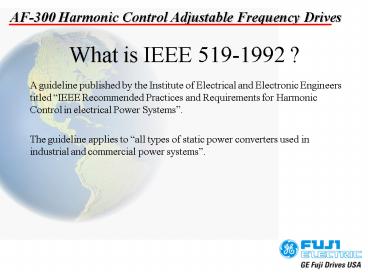What is IEEE 5191992
1 / 23
Title: What is IEEE 5191992
1
What is IEEE 519-1992 ?
A guideline published by the Institute of
Electrical and Electronic Engineers titled IEEE
Recommended Practices and Requirements for
Harmonic Control in electrical Power Systems.
The guideline applies to all types of static
power converters used in industrial and
commercial power systems.
2
The Intent of IEEE 519-1992
- It is a power conditioning recommendation, that
defines limits to levels of harmonic distortion
that should exist in a system. - Its basis is in the need for clean voltage in
facilities that utilize electrical energy. - Original document placed the burden of control on
power-providers - The 1992 revision shifted at least one-half of
the burden to the user. - The user typically shifts the burden onto users
product providers
3
What are Harmonics ?
- Harmonic - A sinusoidal component of a periodic
wave or quantity having a frequency that is a
integral multiple of the fundamental frequency. - Characteristic Harmonics - Those harmonics
produced by semiconductor converter equipment in
the course of normal operation. In a six pulse
converter, the characteristic harmonics are the
non-triple odd harmonics, for example, the 5th,
7th, 11th, 13th, etc.
IEEE 519-1992 Definitions
4
More about Harmonics
Even harmonics (2nd, 4th ) are in phase with the
fundamental, cancel each other and are not a
concern to most installations although even
harmonics do add to the a minor amount to total
line currents. Odd harmonics (3rd, 5th ) are
out of phase with the fundamental, add to
fundamental current and are a major concern to
most installations and do add a significant
amount to the total line currents. Odd harmonics
contribute greatly to the non-sinusoidal current
waveform with non-linear loads such as AC drives.
5
How are harmonics generated ?
- In discontinuous conduction situations non-linear
loads contribute an infinite number of odd and
even harmonic currents. - Harmonic currents are multiples of the
fundamental frequency (60Hz) that are greater
than the fundamental frequency.
6
Problems Harmonics Could Cause
- Elevated RMS current
- Circuit Breaker Trips
- Nuisance Fuse Blowing
- Reduced Equipment Life
- Transformers, Conductors, Breakers, Switches
- Equipment Malfunctions
- High Frequency Currents
- Reduces Effective Power Factor
7
IEEE 519-1992 Definitions
- ISC Short circuit current (utility supply
capability) - IL Maximum demand load current
- PCC Point of Common Coupling (Point where
harmonic - measurements are made - between
the linear and non- - linear loads)
- TDD Total Demand Distortion (Magnitude of
harmonic - distortion as a percent of
maximum demand current) - THD Total Harmonic Distortion (Instantaneous
value of - harmonic distortion)
8
IEEE 519-1992 Guidelines
9
Typical VFD Harmonics
(Without using any filtering techniques)
ISC/IL ITHD - 55 50 - 100 55 - 79 100 - 1000 79 - 120
1000 120
10
The GE Fuji 18 Pulse Drive Solution
40 - 800 HP
11
NEMA 1 Panel Construction
12
The 18 Pulse Advantages
- Fully integrated solution for IEEE 519-1992
Compliance - Can be applied independent of the Point of Common
Coupling - Built on a proven drive design
- Complete set of standard features
- Broad list of factory installed options
- Configurable to meet demanding applications
13
Simple Operation
- Easy to read keypad
- Status LEDs.
- Backlit LCD text display.
- High tactile keys.
- Flexible programming methods
- Remote or local keypad.
- Smart copy function for multiple drives.
14
Easy Start-Up Via Keypad
- LCD monitor
- Smart backlite
- multi - function
- LED Display
- 4 digits
- multi - function
Run Indication Lamp
- Control keys
- keypad operation
- of drive
- Operation keys
- screen switching
- drive configuration
15
Control Flexibility
- Flexible control methods
- Volts / Hertz
- Sensorless Torque Vector
- Accurate speed control
- Reduced speed variations at low speeds (no
cogging) - Wide range of acceleration time (0.01-3600 sec)
- Torque Control
- Torque Limits
16
Available Options
- Relay output card
- Digital I/O interface card
- Analog I/O interface card
- Configured Drive Panel with
- 3 Contactor By-Pass
- Input Disconnect
- Convenient power connections
- etc.
17
Communications Available
- Built-in RS-485 with Modbus RTU Protocol
- Optional communications
- Lonworks
- Jonhson Controls Metasys - N2
- DeviceNet
- Modbus Plus
- Profibus-DP
- Genius
18
Motor Friendly
- Electronic Motor Overload Control can be set
for General Purpose or Inverter Rated Motors - Benefit - Better protection of General
Purpose Motors at low speeds. - How- By adjusting current overload down at
low speeds (Typically 33 of Base Speed)
19
Motor Friendly
- Soft Switching IGBTs !
- Reduce voltage spikes typically found with other
IGBT based Drives - Allows using standard 1000V insulation motors.
- In most cases, eliminates the need for output
filters with 1,300v Insulation motors.
20
Jump Frequency Control
Prevents Mechanical Resonance in Fans and Pumps
21
Typical Applications
Fans Pumps Mixers Agitators Crushers
22
Fan/Pump Application Features
23
Harmonic Mitigation Alternatives
?5 Line Reactor 30 - 35 THID ? 5 Line
Reactor 3 DC Choke 25 - 30 THID ? 5th Tuned
Harmonic Trap 20 - 30 THID ? 5th 7th Tuned
Harmonic Traps 12 - 20 THID X 12 - Pulse Drive
(balanced line currents) 15 THID ? 18 - Pulse
Drive (balanced line currents) Band Harmonic Filters 5 - 12 THID































